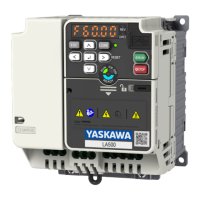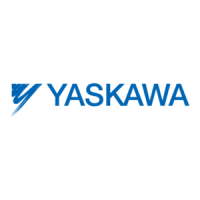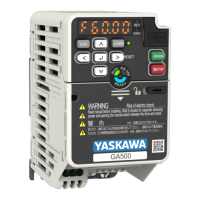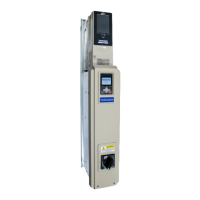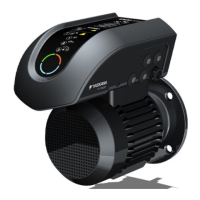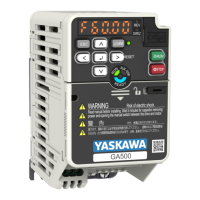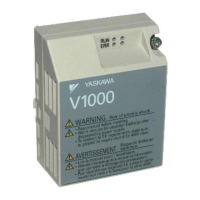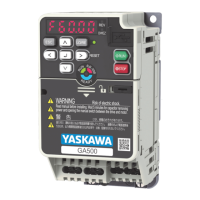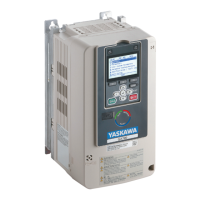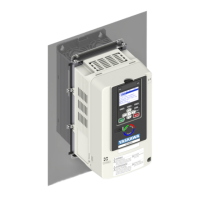6 DCP Interface
64 YASKAWA TOEPC710616134G AC Drive L1000A Technical Manual Addendum
◆ Positioning
■ Velocity Profile Input Control
Taking Ramping Times [C1-01, C1-02] and Jerk Settings [C2-01 to C2-04] of the drive into account, a suitable
velocity profile is determined which matches the remaining distance and which does not exceed the limiting DCP
speed. The limiting DCP speed is transferred by the lift controller to the drive before the travel starts.
Besides the velocity profile input control, a shaft controller aligns the traveled distance based on motor PG with
the lift car position based on shaft PG. In order to reduce the control effort for the shaft controller, o1-20, o1-21,
and o1-22 settings must be accurate. It is especially recommended to set o1-20 as exact as possible (rope-center to
rope-center value).
As mentioned before, an optimal setting of o1-20 greatly improves positioning performance. A coarse tuning at
the beginning of commissioning is usually done by comparing the lift speeds shown by lift and drive controller. In
this case, the lift car is typically moved in inspection speed. When the lift controller shows higher speeds than the
drive, o1-20 setting needs to be lowered; when it shows slower speeds, increase o1-20.
■ Shaft Controller Tuning
The shaft controller compares the remaining distance to travel with the remaining distance based on motor PG. In
some cases, especially with high pulse count PGs, it is necessary to reduce the Shaft Controller Output Gain [S7-
13].
◆ Adjustment Procedures
General Tuning Requirements for Profile Position Mode
1. Select Drive control method (CLV or PM CLV; requires pulse counter (PG) feedback).
2. Perform Auto-tuning.
3. Set H5-13 = 4 (profile positioning is performed with setting 4).
4. When you use a lift controller from Böhnke & Partner or from Kollmorgen, set S7-40 = 0. If you use a lift
controller from any other manufacturer, set S7-40 = 1.
5. Tune complete ASR, i.e. C5-01/C5-03/C5-13, C5-02/C5-04/C5-14.
It is very important to have a fast ASR response time in order to obtain good leveling results. This is mainly
achieved when C5-02/C5-04/C5-14 have low values (< 100ms). Higher C5-01/C5-03/C5-13 values (ASR
gains) are also recommended.
6. Set o1-20, o1-21, o1-22 values, especially o1-20, as precise as possible (set the sheave diameter from rope-
center to rope-center if possible).
7. Compare speeds of lift controller and drive controller using inspection speed.
These values should be similar with a tolerance of about 3%. If deviations are bigger, adjust o1-20.
Recommendation: Switch drive controller units to m/s (o1-03 = 4).
8. Perform a DCP4 positioning travel one floor up or down.
■ Shaft Controller Tuning
The shaft controller compares the remaining distance to travel with the remaining distance based on motor PG.
Usually, you do not need to tune this function. But in case of high PG-PPR values, the shaft controller output gain
[S7-13] should be reduced.
■ Optional: Zero-Servo Tuning
The last bit of the distance (1 to 3 mm) during a positioning operation can be performed by the Zero-Servo
controller. Its properties are governed by S3-xx parameter group. With higher gain settings (S3-03 [Stop Position
Lock Gain]), the remaining leveling error is driven by a quick movement which can be undesired.
The remaining distance after deceleration by ASR controller (end of C2-04 time) is fed into the Zero-Servo
function at that threshold. The maximum speed during that correction can be limited by S3-05. With slower
speeds, the correction takes longer but possibly yields a higher riding comfort and is less discernible. A
compromise has to be found. To avoid any roll-back at stop, set S3-05 = 0.
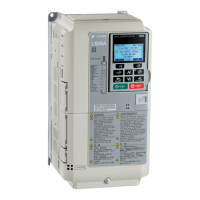
